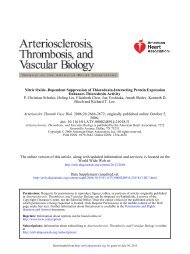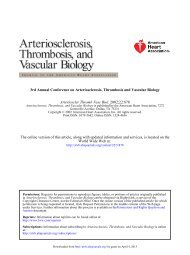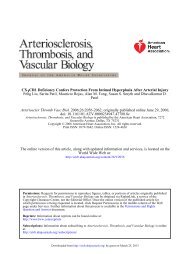1994;14;1751-1760 Arterioscler Thromb Vasc Biol AH Lichtenstein ...
1994;14;1751-1760 Arterioscler Thromb Vasc Biol AH Lichtenstein ...
1994;14;1751-1760 Arterioscler Thromb Vasc Biol AH Lichtenstein ...
- TAGS
- 1994
You also want an ePaper? Increase the reach of your titles
YUMPU automatically turns print PDFs into web optimized ePapers that Google loves.
TABLE 1. Composition of the Study Diets As<br />
Determined by Chemical Analysis<br />
Diet<br />
Variable Baseline Reduced Fat Low Fat<br />
Protein, %<br />
Carbohydrate, %<br />
Fat, %<br />
SFA,%<br />
12:0<br />
<strong>14</strong>:0<br />
16:0<br />
18:0<br />
MUFA, %<br />
16:1<br />
18:1<br />
PUFA,%<br />
18:2 n6<br />
18:3 n3<br />
20:4 n6<br />
Cholesterol,<br />
mg/1000 kcaJ<br />
16.5±0.5<br />
48.1 ±2.9<br />
35.6+2.4<br />
12.90±1.97<br />
0.37±0.03<br />
1.45±0.22<br />
6.86±0.96<br />
3.29±0.67<br />
12.17±1.60<br />
0.05±0.10<br />
11.16±1.29<br />
7.94±0.75<br />
6.95±0.66<br />
0.82±0.06<br />
0.06±0.01<br />
128±21<br />
17.4 t0.9<br />
53.3 t2.4<br />
29.4 t1.5<br />
6.90 t0.60<br />
0.09 t0.01<br />
0.04 t0.04<br />
4.33: t0.30<br />
1.60 t0.21<br />
8.98: t0.64<br />
0.30 fcO.08<br />
8.40 t0.55<br />
11.21 t0.52<br />
10.67 t0.53<br />
0.40 t0.06<br />
0.05: t0.01<br />
<strong>Lichtenstein</strong> et al Low-Fat Diet, Weight Loss, and Plasma Lipids 1753<br />
16.9±0.6<br />
68.0:<br />
15.1: :2.6<br />
5.01: :0.93<br />
0.12d :0.02<br />
0.47: :0.09<br />
2.77d:0.46<br />
1.36d:0.31<br />
4.86d:0.657<br />
0.24: :0.02<br />
4.46: :0.64<br />
2.54: :0.50<br />
2.20: :0.42<br />
0.26; :0.06<br />
0.04: :0.01<br />
85±4 73±3<br />
SFA indicates saturated fatty acids; MUFA, monounsaturated<br />
tatty acids; and PUFA, polyunsaturated fatty acids. See "Methods"<br />
for definitions of diets. Values are mean±SD; n=3.<br />
tein determinations. On one day during the final week of the<br />
first three phases or during weeks 5 and 10 of the low-fat (J,<br />
energy) phase subjects consumed their three meals plus one<br />
snack at standardized intervals, and blood was sampled at 0, 5,<br />
8, 10, and 24 hours.<br />
Biochemical Analysis<br />
Fasting (12-hour) blood was collected in tubes containing<br />
0.1% EDTA, and very-low-density lipoprotein (VLDL) was<br />
isolated from plasma by a single ultracentrifugational spin at<br />
density 1.006 g/mL (39 000 rpm for 18 hours at 4°C). Plasma<br />
and the 1.006-g/mL infranate were assayed for total cholesterol<br />
and/or triglyceride with an Abbott Diagnostics ABA-200<br />
bichromatic analyzer using enzymatic reagents. 33 HDL-C was<br />
measured as described, 54 and non-HDL-C (total cholesterol<br />
minus HDL-C) was determined in nonfasting plasma after<br />
HDL-C precipitation. Lipid assays were standardized through<br />
the Lipid Standardization Program of the Centers for Disease<br />
Control and Prevention, Atlanta, Ga. Within-run and between-run<br />
coefficients of variation of these assays were less<br />
than 5%.<br />
Apolipoprotein (apo) B was assayed with a noncompetitive,<br />
enzyme-linked assay by using immunopurified polyclonal antibodies<br />
53 in plasma after VLDL had been removed. Plasma<br />
apoA-I was assayed in the same manner by using apoA-I<br />
polyclonal antibodies. 56 Coefficients of variation for both assays<br />
were less than 5% within runs and less than 10% between<br />
runs. Assays were standardized with LDL containing only<br />
apoB and purified apoA-I with the protein content determined<br />
by amino add analysis. Lipoprotein(a) [Lp(a)] was quantified<br />
by using an enzyme-linked assay with a monoclonal antibody<br />
that did not cross-react with plasminogen as the first antibody<br />
and a polyclonal antibody as the second antibody that was<br />
directed against the apo(a) portion of the Lp(a) particle<br />
(Terumo Medical Corp). Lp(a) concentrations are expressed<br />
as total Lp(a) mass in milligrams per deciliter. 57<br />
TABLE 2. Baseline Characteristics of the<br />
Study Subjects<br />
Variable<br />
Women<br />
(n=6)<br />
Men<br />
(n=5)<br />
Mean<br />
Age, y 66±12 54±12 60±13<br />
Body weight, kg 69+18 82±<strong>14</strong> 75+17<br />
Height, cm 159±3 175±10 166±10<br />
Body mass index, kg/m 2 27.2+6 0 26.8±2.4 27.0±4.5<br />
Total cholesterol, mg/dl 243+32 244±11 243±23<br />
VLDL cholesterol, mg/dL 27+7 29±12 28±9<br />
LDL-C, mg/dL 167±28 173±15 169±22<br />
HDL-C, mg/dL 50+9 42±12 46±10<br />
Triglycerides, mg/dL 135±35 <strong>14</strong>4±61 139±46<br />
TC/HDL-C 5.03±1.13 6.16±1.79 5.55±1.51<br />
VLDL indicates very-low-density lipoprotein; LDL-C, low-density<br />
lipoprotein cholesterol; HDL-C, high-density lipoprotein cholesterol;<br />
and TC, total cholesterol. Values are mean±SD.<br />
Statistical Analysis<br />
The data were analyzed by using SAS (STATISTICAL ANALYSIS<br />
SYSTEM; SAS Institute Inc) both for the IBM-compatible<br />
personal computer using version 6.04 and as run on a VAX<br />
mainframe (Digital Equipment Corp), PROC GLM was used for<br />
ANOVA procedures for repeated measures followed by<br />
Tukey's t test performed at the ^=.05, .01, and .001 levels of<br />
comparison.<br />
Results<br />
The mean age of the study subjects was 60 ±13 years<br />
(Table 2); all subjects had somewhat elevated body mass<br />
indexes. At the time of screening they had a mean<br />
LDL-C concentration of 169±22 mg/dL. The women<br />
tended to have higher HDL-C and lower LDL-C concentrations<br />
than the men.<br />
The consumption of the reduced-fat diet (29% of<br />
calories as fat) resulted in 13%, 18%, and 10% decreases<br />
in total cholesterol, LDL-C, and HDL-C concentrations,<br />
respectively, relative to the baseline diet<br />
(36% of calories as fat) (Table 3 and Fig 1). Changes in<br />
LDL apoB concentrations mirrored those of LDL-C. In<br />
contrast, despite a decrease in HDL-C concentrations,<br />
there was little change in the concentration of apoA-I.<br />
These changes resulted in similar total cholesterol/<br />
HDL-C ratios but significantly lower LDL apoB/apoA-I<br />
ratios. No significant effects of consuming the reducedfat<br />
diet on the concentrations of triglyceride and Lp(a)<br />
relative to the baseline diet were observed.<br />
When the fat content of the diet was decreased to<br />
15% of calories and consumed at isocaloric levels (low<br />
fat [-> energy]), there was a less favorable effect on<br />
plasma lipid levels than when the fat content of the diet<br />
was reduced to only 29% of calories. Relative to the<br />
baseline diet, there were 7%, <strong>14</strong>%, and 25% decreases<br />
in total cholesterol, LDL-C, and HDL-C concentrations<br />
during the low-fat (-» energy) period (Table 3 and Fig<br />
1). These changes were accompanied by dramatic increases<br />
in VLDL cholesterol (95%) and triglyceride<br />
(75%) concentrations.<br />
Relative to the baseline diet the decrease in LDL<br />
apoB concentrations (-17%) was similar to that observed<br />
for LDL-C concentrations (-<strong>14</strong>%); however, as<br />
Downloaded from<br />
http://atvb.ahajournals.org/ by guest on December 7, 2012














